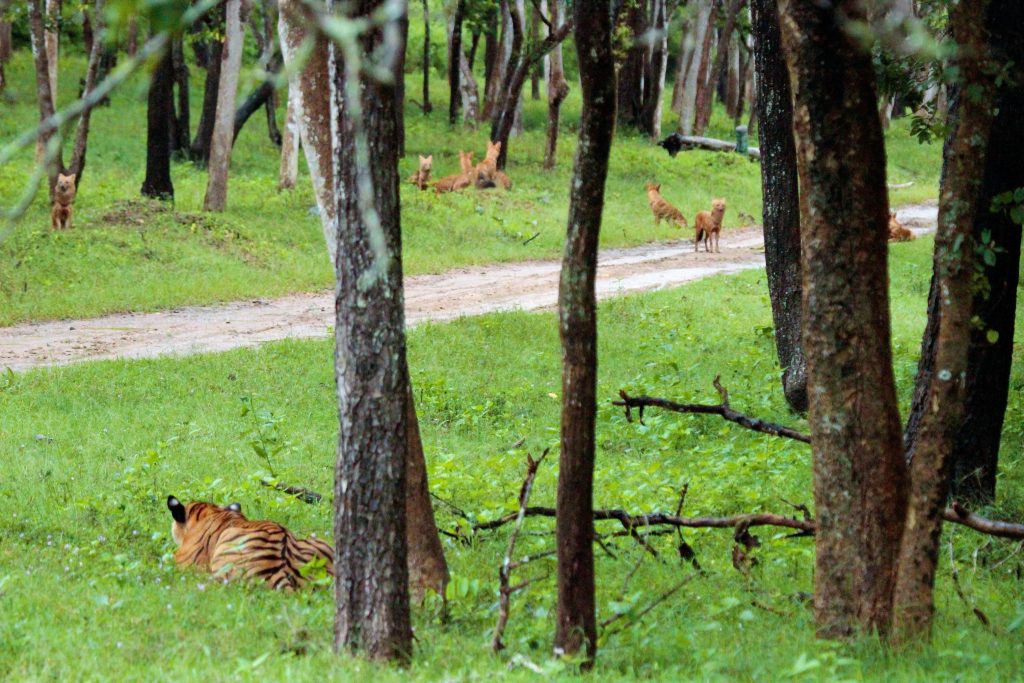Large carnivores like dholes, leopards and tigers, which compete for the same food resources, use several tactics to avoid each other while still co-occuring in the same spaces. Understanding the nuances of their interactions has been of interest to ecologists for a long time. What happens when formidable large carnivores encounter each other? Who wins or who loses? Do they kill each other? Does the availability of prey alter these equations? These interactions, beyond enabling the coexistence of the carnivores themselves, are also important in maintaining the ecological balance in their ecosystems. Unfortunately, since the three carnivores mostly occur in dense forest habitats, making direct observations to fully understand their interactions poses several challenges.
In a recent study, researchers from the National Centre for Biological Sciences–TIFR and Wildlife Conservation Society–India adopted a unique approach to examine how these carnivores compete and coexist in the forests of Asia. Combining information from over 100 sources (1871 to 2022) that included published papers (traditional sources), together with information from social media and wildlife documentaries (novel sources), the authors examined how dholes, leopards and tigers interact with each other in terms of space, time and diet.
The three carnivores have witnessed drastic range contractions in the last 100 years and are now threatened with extinction. Most of their source populations are now confined to small and oftentimes isolated forested Protected Areas. This coerces the three species to share the same, limited space. Analysis of one-on-one encounters between these carnivore pairs revealed a social hierarchy: tigers were usually dominant over dholes; but dholes could sometimes combat this when their pack sizes were large. On the other hand, leopards remained subordinate to both their co-predators.
Tigers and dholes primarily consumed wild ungulate herbivores, while leopards showed relatively higher propensity for primate and domestic livestock prey. Synthesis of diet data from 15 locations across south and southeast Asia showed that the three predators together harvested 0.8% to 30.2% of the available wild ungulate prey biomass in these forests. The authors found evidence to show that when prey availability is low, the co-predators avoid each other in space, but are active during each others’ time periods of high activity. On the other hand, when prey availability is high, they overlap with each other in space, but can comfortably avoid each others’ time periods of high activity.
The authors then made predictions for 40 Protected Areas in India where information on leopard, tiger and wild prey densities were available from the All India Tiger Estimation exercise. In 20 of these Protected Areas where prey availability is low, the three carnivores are likely to show high levels of competition; in very low prey areas this could possibly lead to the ‘exclusion’ of one or more species (leopards may be the first to lose, because they are subordinate to the other two). For 20 Protected Areas where prey availability is high, competition may not be evident between the species because they can now coexist. At the same time, high prey densities lead to increase in carnivore densities; in extreme cases, this may translate to high competition within the same species. When this happens, the younger individuals or the really old ones get pushed to the forest edges, increasing the risks of livestock depredation.
The results of this study emphasize on the delicate balance between prey availability, predator competition, and their consequences for managing these carnivore populations. In doing so, the study shows how fundamental ecology (competition, predation, species interactions) can be important for guiding the conservation of isolated populations of imperiled carnivores in Asia and other similar habitats across the tropics.
Citation: Srivathsa, A., Ramachandran, V., Saravanan, P., Sureshbabu, A., Ganguly, D. & Ramakrishnan, U. (2023) Topcats and underdogs: Intraguild interactions among three apex carnivores across Asia's forestscapes. Biological Reviews. doi: 10.1111/brv.12998
Weblink:
https://onlinelibrary.wiley.com/share/author/A5MJRKCDIXZHWEWPRNDT?target=10.1111/brv.12998


 CI is a non-profit, non-commercial portal that aims to facilitate wildlife and nature conservation by providing reliable information and the tools needed to campaign effectively.
CI is a non-profit, non-commercial portal that aims to facilitate wildlife and nature conservation by providing reliable information and the tools needed to campaign effectively.